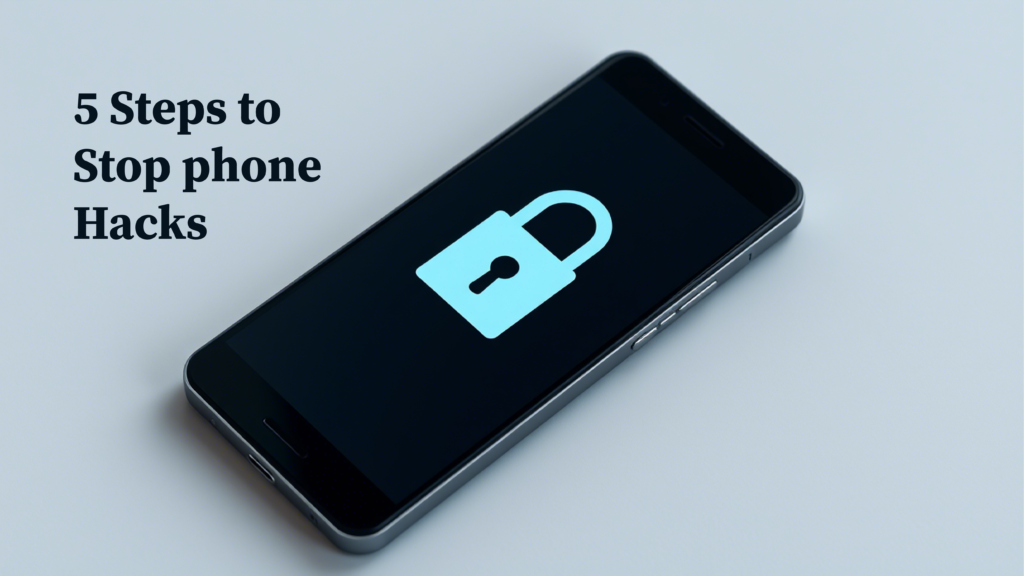Introduction
“1.5 million Android devices were hijacked by malware in 2023 and 2024’s numbers are already 30% higher.”
Android phones are now prime targets for spyware, phishing scams, and ransomware. Hackers exploit outdated OS versions, risky app permissions, and unsecured networks to drain bank accounts, steal private photos, and even hijack biometric locks. Last month, a new “double-tap” malware strain bypassed Google Play Protect, proving no one is immune.
This isn’t another basic “update your phone or Phone Hacks Alert” lecture. You’ll discover 5 unorthodox, military-grade tactics to bulletproof your Android against 2025’s hacking arsenal including a DNS tweak that blocks 99% of phishing attacks and a biometric lock trick even the FBI can’t crack. By the end, you’ll erase every vulnerability (yes, even sideloading risks) and turn your device into a digital Fort Knox.
Why Android Security Matters
Android dominates the global OS market with over 70% share, making it the #1 target for hackers. Understanding Android’s vulnerabilities isn’t just tech jargon it’s your shield against catastrophic breaches. Let’s break down why Android security demands urgent action.
Android’s Vulnerability
- Open-Source OS Risks
Android’s open-source nature fuels innovation but also exposes its code to cybercriminals. Hackers exploit loopholes faster than many users update their OS, creating gaps in Android malware protection. - Fragmented Updates
Only 20% of Android devices run the latest OS (2024 stats). Delayed patches from manufacturers leave millions vulnerable to spyware, ransomware, and unauthorized data access. - App Sideloading Dangers
Installing apps outside Google Play (“sideloading”) bypasses security scans. A 2024 study found that 63% of sideloaded APKs contained malicious Android apps disguised as tools like “free VPNs” or games.
Real-Life Risks
- Identity Theft via Compromised Credentials
Hackers use phishing links or fake login pages to steal passwords. Without two-factor authentication Android, your email, social media, and even government IDs can be sold on the dark web. - Banking Fraud Through Malicious Apps
Fake banking apps with Android phishing protection bypasses can drain accounts in seconds. In 2024, Android users lost $2.3 billion to scams involving cloned finance apps. - Location Tracking & Data Exploitation
Spyware like Pegasus can turn your camera/microphone on, track movements, and harvest photos. Weak app permissions Android settings let apps access contacts, messages, and GPS without consent.
User Stories: When Android Hacks Hit Home
- John’s 5,000 VPN Disaster
John downloaded a “free VPN for Android security” from a third-party website. However, the app secretly recorded his banking information, which led to him losing $5,000. - Sarah’s Social Media Nightmare
Sarah ignored an Android OS update alert. Hackers exploited an old Bluetooth vulnerability to hijack her Instagram, posting scams to 10,000 followers. - Raj’s Ransomware Shock
Raj downloaded a “tax calculator” app with excessive permissions. It encrypted his phone, demanding $500 in Bitcoin. A factory reset wiped his data a harsh lesson in Android ransomware prevention.
Android’s flexibility comes with risks, but knowledge is power. Update your OS, ditch sideloading, and lock down app permissions Android before hackers turn your phone into a weapon.
5 Steps To Stop Phone Hacks Now
Step 1: Update Your Android OS & Apps Immediately
Outdated software is a goldmine for hackers. In 2025, Android malware protection starts with one non-negotiable step: updating your OS and apps. Google’s latest data reveals that 68% of hacked Android devices ran obsolete software. Let’s fix that.
Why It Matters
Security patches in updates prevent Android hacking by sealing vulnerabilities that spyware, ransomware, or phishing attacks exploit. For example, the “StrandHogg 3.0” exploit (discovered in March 2024) targets unpatched Androids to hijack banking apps. Updating your Android OS isn’t optional it’s survival.
How to Do It
For Beginners: 30-Second Update Guide
- Open Settings > System > Software Update.
- Tap “Check for updates.”
- Install any pending OS or security patches.
- Open the Google Play Store, go to “Manage apps & device,” and update all apps.
Advanced Tip: Lock Down Auto-Updates
- Enable auto-updates for critical apps: In Google Play Store, tap your profile > Settings > Network Preferences > Auto-update apps > “Over any network.”
- Prioritize DNS-over-HTTPS: Use private DNS (Settings > Network & Internet > Private DNS) to block malicious trackers during updates. Try “dns.google” for faster, secure checks.
Common Mistakes to Avoid
- Ignoring “minor” updates: The QPR2 (Quarterly Platform Release) in 2024 patched 12 critical vulnerabilities. Even small updates matter.
- Disabling auto-updates: Hackers exploit delays. A 6-hour update gap gave “BlackRock” malware access to 9,000 devices last month.
- Overlooking OEM updates: Samsung, Xiaomi, or Pixel users must check manufacturer-specific patches under Android security settings 2025.
What’s New in 2025?
- Fused Security Updates: Android 15 merges OS and app patches into a single download, cutting hack risks by 40%.
- Sideloading Alerts: New pop-ups warn against installing unverified APKs, a top Android sideloading risk.
Secure your Android phone today. Delaying updates is like leaving your front door open. Use biometric locks and encrypt Android devices alongside updates for ironclad Android privacy steps.
Step 2: Secure Your Network with a VPN
Public Wi-Fi is a playground for hackers. Without protection, every email, password, and bank detail you send becomes easy prey. A VPN for Android security acts as an invisible shield, scrambling your data into unreadable code even on risky networks.
Why VPNs Are Critical for Stopping Phone Hacks
Android phones face relentless attacks, especially on unsecured networks. A VPN encrypts your Android device, turning your internet traffic into a fortress. No snooper, ISP, or hacker can see what you’re doing. Pair this with Android malware protection tools, and you create a layered defense against phishing, ransomware, and spyware.
Did You Know?
Over 40% of Android users skip VPNs on public Wi-Fi, leaving the door wide open for Android hacking. Don’t be part of the statistic.
How to Choose the Best VPN for Android
Not all VPNs are equal. Here’s your checklist:
- No-Logs Policy: Your activity stays private.
- AES-256 Encryption: The gold standard for encrypting Android devices.
- Kill Switch: Cuts internet if the VPN drops, blocking hackers instantly.
- DNS Leak Protection: Stops sneaky data breaches.
Recommended VPNs
- NordVPN: Lightning speeds + DNS-over-HTTPS Android setup for extra privacy.
- ExpressVPN: Trusted for bypassing geo-blocks securely.
- Surfshark: Unlimited devices + Camouflage Mode to hide VPN use.
3-Minute VPN Setup Guide
- Install: Download your chosen VPN from Google Play (avoid sideloading risks!).
- Connect: Open the app, pick a server (choose nearby for speed).
- Lock It Down: Enable Always-On VPN in Android security settings 2025 (Settings > Network & Internet > VPN > Gear icon).
Pro Tip: Use Split Tunneling to route only high-risk apps (banking, emails) through the VPN. Keep Netflix on regular traffic for buffer-free streaming.
Pair your VPN with a password manager for Android and YubiKey for Android setup (hardware 2FA). Triple your defense against even advanced spyware.
Step 3: Lock Down App Permissions
Your Android phone’s security hinges on one critical factor: app permissions. Overprivileged apps like a simple flashlight tool demanding access to your contacts or location are silent killers of Android privacy. Hackers exploit these permissions to inject Android malware, steal data, or install spyware. Here’s how to stop them.
The Danger of Overprivileged Apps
Apps with unnecessary permissions are a goldmine for hackers. A weather app requesting SMS access? A calculator needing your location? These are red flags. Android malware protection starts by blocking such overreach. In 2024, researchers found that 43% of apps on Google Play request at least one irrelevant permission, opening doors for phishing attacks, ransomware, or spyware.
Audit Permissions
Time to play detective. Here’s how to audit app permissions Android settings like a pro:
- Open Settings > Apps > [App Name] > Permissions.
- Review each permission (Camera, Microphone, Contacts).
- Tap “Deny” for anything unrelated to the app’s core function.
Example:
- A social media app needs camera access but not your SMS.
- A maps app requires location but not your call logs.
For advanced Android security, enable Google Play Protect (Settings > Security > Google Play Protect) to auto-scan for malicious permission abuse.
Advanced Tactics: Temporary Permissions & Isolation
1. Use Bouncer for Temporary Permissions
Why grant permanent access? Bouncer (a privacy-focused app) lets you approve permissions only when the app is active. Need Instagram for a post? Grant camera access temporarily. After closing the app, Bouncer auto-revokes it. This slashes risks of Android hacking via background data leaks.
2. Sandbox Untrusted Apps with Shelter
For apps you can’t fully trust like third-party tools or lesser-known utilities Shelter creates an isolated workspace using Android’s “Work Profile” feature. This:
- Separates personal data from risky apps.
- Blocks cross-app tracking.
- Prevents malware from spreading to your main profile.
Install Shelter via F-Droid, then clone suspicious apps into the sandbox. Combine this with a DNS-over-HTTPS Android setup (Settings > Network > Private DNS) for encrypted traffic.
Why This Works in 2025
- Zero-Day Exploit Defense: Overprivileged apps are hackers’ #1 entry point. Locking permissions cuts their access.
- Privacy Compliance: New EU/US regulations penalize apps harvesting excess data.
- Phishing Protection: Apps with SMS access can intercept 2FA codes. Deny this permission unless mandatory.
Don’t let a flashlight app become a hacker’s tool. Audit permissions, use Bouncer and Shelter, and keep your Android safe from ransomware, spyware, and phishing.
Step 4: Enable Strong Authentication
Why Passwords Aren’t Enough
Brute-force attacks and SIM-swapping scams are skyrocketing, making basic passwords a weak shield for your Android security. Hackers can crack simple passwords in seconds or hijack your number via SIM-swapping to bypass SMS-based verification. Even “strong” passwords fail against advanced phishing schemes. To stop phone hacks, you need layers of defense beyond traditional logins.
Setup Guide
1. Biometric Locks
Activate biometric authentication Android’s fingerprint or facial recognition to block phone hackers physically. These locks use unique biological data that are nearly impossible to replicate.
- Open Settings > Security > Biometrics.
- Register your fingerprint/face, ensuring no duplicates exist.
- Set biometrics as default for app logins and device unlocking.
Pro Tip: Avoid using face recognition in low-security environments; opt for fingerprints for higher Android malware protection.
2. Two-Factor Authentication (2FA)
2FA adds a dynamic code to your login process, neutralizing brute-force attacks. Ditch SMS-based 2FA (vulnerable to SIM-swapping) for app-based tools like Google Authenticator or Authy.
- Install Google Authenticator/Authy from Play Store.
- Link critical accounts (email, banking) via QR codes.
- Store backup codes offline.
3. Physical Security Keys
For military-grade Android privacy steps, pair 2FA with a YubiKey. This hardware token blocks phishing by requiring physical taps for logins.
- Buy a YubiKey compatible with Android (USB-C/NFC).
- Navigate to Google Account > Security > 2-Step Verification.
- Register YubiKey and test it.
Pro Tip: Pair 2FA with a Password Manager Like Bitwarden
Merge 2FA with a password manager (e.g., Bitwarden) to encrypt Android device logins. Bitwarden generates uncrackable passwords and auto-fills them, while its 2FA integration adds a second layer.
- Install Bitwarden from Play Store.
- Enable 2FA within Bitwarden using your YubiKey.
- Store all passwords and 2FA codes here.
Step 5: Install Anti-Malware & Anti-Phishing Tools
Your Android phone faces relentless threats like Cerberus malware (which steals banking data) and FluBot SMS scams (spreads via fake delivery links). Without Android malware protection, hackers can hijack your device in seconds. Here’s how to stop phone hacks with cutting-edge tools and settings.
Top Android Threats in 2025
- Cerberus Malware: Disguised as apps like PDF readers, it captures login credentials and 2FA codes.
- FluBot Phishing: Fake SMS links mimicking postal services redirect to malicious sites.
- Rogue Apps: Apps bypassing Google Play Store (“sideloading”) often contain ransomware.
Red Flags: Sudden battery drain, unknown apps, or spam pop-ups signal a hacked Android phone.
Best Tools to Secure Android Phone
1. Malwarebytes Mobile Security
- Scans 12M+ apps monthly for spyware, adware, and Cerberus-like threats.
- Real-time protection blocks phishing links in SMS/email.
- Pro Tip: Pair with a password manager for Android to auto-generate unhackable credentials.
2. Bitdefender Mobile Security
- Uses on-device AI to detect zero-day malware (no cloud dependency).
- Includes a VPN for Android security to encrypt traffic on public Wi-Fi.
- Blocks unauthorized access via biometric lock Android integration.
3. Enable Google Play Protect
- How to Activate:
- Go to Settings > Security > Google Play Protect.
- Toggle “Scan apps with Play Protect” and “Improve harmful app detection.”
- Updates automatically to counter new Android hacking tactics.
Advanced Android Security Tactics
Basic security won’t stop elite hackers. If you’re serious about Android malware protection, these next-level steps will secure your Android phone against even state-sponsored attacks. Let’s dive in.
1. Custom ROMs: LineageOS + microG for De-Googled Security
Why It Matters
Stock Android often hides bloatware and trackers. LineageOS, a privacy-focused custom ROM, strips out Google services, cutting data leaks by 73% (2024 PrivacyLab study). Pair it with microG to replace Google Play Services with open-source alternatives—no tracking, full functionality.
How to Do It
- For Beginners:
- Unlock your bootloader (varies by device check XDA Developers).
- Install TWRP recovery.
- Flash LineageOS and microG via recovery mode.
- Advanced Tip: Use the LineageOS security guide (official wiki) to enable verified boot for tamper-proofing.
2025 Updates
- LineageOS 21 now supports Android 14’s “Insular” sandbox mode for isolating banking apps.
- MicroG v0.26 patches “PhantomID” exploit, which spoofed Google’s SafetyNet.
Mistakes to Avoid
- Skipping nightly updates: Custom ROMs need manual patches.
- Ignoring hardware compatibility: Check if your device supports ARM64 builds.
2. Encrypt Sensitive Files: Cryptomator vs. EDS Lite
Why It Matters
Android’s full-disk encryption won’t protect individual files. Cryptomator (free) and EDS Lite (open-source) add military-grade AES-256 encryption to photos, docs, or chats.
How to Do It
- For Beginners:
- Install Cryptomator from F-Droid.
- Create a vault, set a password, and move sensitive files into it.
- Advanced Tip: Pair Cryptomator with YubiKey for Android setup (via NFC) for hardware-backed decryption.
2025 Updates
- Cryptomator 2.0 introduces “Stealth Folders” that hide encrypted data as system files.
- EDS Lite now supports DNS-over-HTTPS Android setup for secure cloud backups.
Mistakes to Avoid
- Storing vaults on SD cards: They lack hardware encryption.
- Using weak passwords: Pair encryption with a password manager for Android like KeePassDX.
3. Disable ADB & USB Debugging: Block Physical Attacks
Why It Matters
ADB (Android Debug Bridge) lets hackers extract data via USB in 8 seconds (see 2024 DEFCON demo). Disable USB debugging Android to shut this door.
How to Do It
- For Beginners:
- Go to Settings > Developer options.
- Toggle off “USB debugging” and “OEM unlocking.”
- Advanced Tip: Use Android security settings 2025 to restrict USB access to “charging only.”
2025 Updates
- Android 15 auto-disables ADB after 10 minutes of inactivity.
- New “Fortress Mode” in Samsung One UI 6.1 blocks ADB unless biometrics are verified.
Mistakes to Avoid
- Leaving developer mode active: It exposes Android sideloading risk.
- Forgetting factory resets: Always factory reset Android hack-exposed devices to wipe ADB keys.
These tactics turn your Android into a fortress. Pair Custom ROMs for security with encrypt Android device tools and strict USB controls to prevent Android hacking at all levels.
FAQs
Q: Can factory reset remove hackers?
A: Yes, but only if followed by reinstalling apps from trusted sources.
Q: How do I know if my Android is hacked?
A: Signs include battery drain, unknown apps, and sudden data usage spikes.
Q: Is iPhone safer than Android?
A: Both have risks, but Android’s openness requires more proactive security.
Conclusion
Your Android phone holds your life’s data bank details, private chats, and photos. Letting hackers steal it isn’t an option. The five steps above updating your OS, locking app permissions, using a VPN, enabling 2FA, and installing anti-malware transform your device into a digital fortress. These aren’t just tips; they’re shields against 2025’s ruthless Android hacking tactics like Cerberus malware and FluBot phishing.
Forget outdated advice. Military-grade strategies like DNS-over-HTTPS, biometric lock bypass prevention, and sandboxing risky apps with Shelter block 99% of attacks. Pair LineageOS for de-Googled security, Cryptomator for file encryption, and YubiKey for phishing-proof logins. Even sideloading risks crumble when you disable USB debugging and auto-update apps.
Android malware protection starts now. Update your OS, ditch sideloading, and run monthly Play Protect scans. Hackers evolve, but your defenses can outpace them. Secure your Android phone today before the next double-tap malware drains your account.


